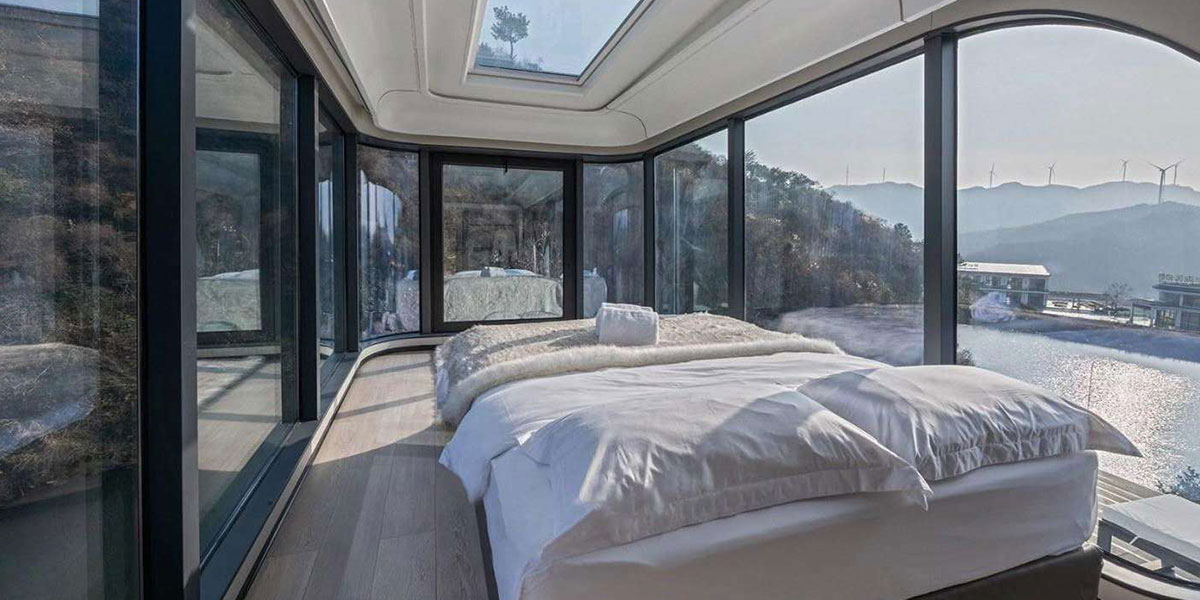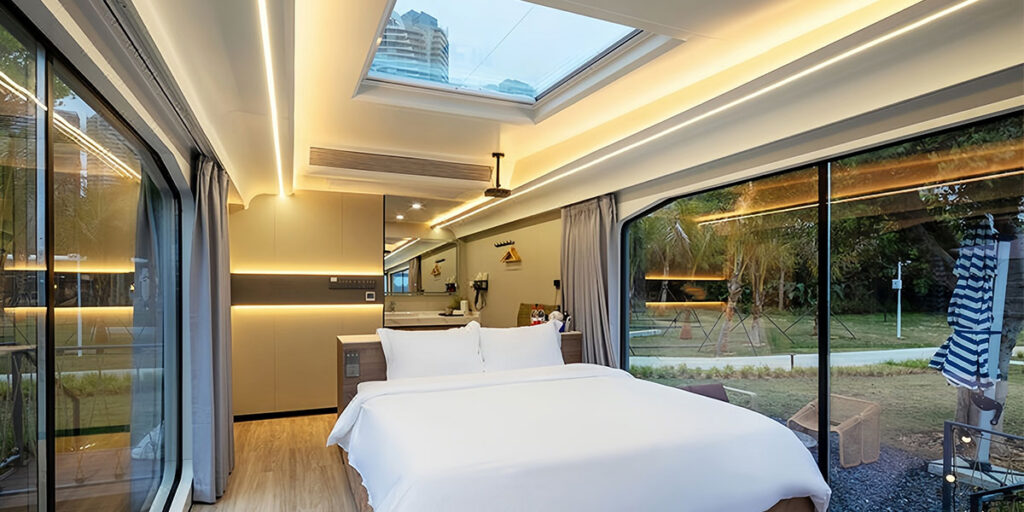
17 Jun Space Capsule Houses Compared to Traditional Tiny House
Table of Contents
Have you ever thought about why Space Capsule Houses are cool? These modern homes use smart ideas in every small space. They have modular designs, smart technology, and save lots of room. Traditional tiny houses are cute but don’t have these advanced features.
Key Takeaways
Space capsule houses have cool designs and smart tech. They are easy to change and very efficient.
Traditional tiny homes feel warm and personal. They use green materials and can look very unique.
Capsule houses usually cost less to buy and fix. Traditional homes are more about style and being special.
Design and Looks
Cool Look of Space Capsule Houses
Space capsule houses look like they belong in sci-fi movies. Their designs feel super modern with bold shapes and cool features. You’ll see shapes like circles, cones, and spheres that make them look sleek. Bright colors like red, orange, and blue make them pop even more.
What’s awesome is how easy they are to change. Their modular design lets you move or add parts to fit your needs. Some even have artistic shapes that make them feel like sculptures. Plus, they come with smart tech! You can control lights, temperature, and security right from your phone.
If you love new ideas and want a futuristic home, space capsule houses are perfect.
Cozy Style of Traditional Tiny Homes
Traditional tiny homes are all about being cozy and personal. You can use natural materials like cob, adobe, or straw to build them. These materials are eco-friendly and help keep your home warm in winter and cool in summer.
You can also design them to save space. Many have furniture that does two jobs or hidden storage to use every inch. Want your home on a trailer? You can pick options like low trailers for more headroom or square wheel wells for better insulation.
These homes let you make every detail your own. Whether you like rustic charm or simple modern looks, you have so many choices.
Cost and Affordability
Comparing Upfront Costs
Space capsule houses are often cheaper to buy first. They usually cost $20,000 to $100,000. Traditional prefab homes can cost over $200,000. This big price difference matters for new buyers or downsizers.
Capsule houses save money because they use fewer materials. Their modular design also needs less work to build. Prefab homes need more resources and skilled workers, which raises costs.
But price isn’t the only thing to think about. Capsule houses have cool designs and smart features. Prefab homes offer cozy looks and more ways to customize them.
Long-Term Savings with Capsule Houses
Capsule houses save money later, not just at first. They are made to use less energy. Many have solar panels, smart thermostats, and insulated walls. These features lower energy bills over time.
Capsule houses also cost less to fix. Their strong materials and simple designs need fewer repairs. Prefab homes may need more care, especially if made with natural materials.
Capsule houses are great for saving money now and later. They are a smart pick for buyers on a budget. But if you love the charm of prefab homes, spending more might be worth it.
Sustainability and Environmental Impact

Environmental Benefits of Capsule Houses
Space capsule houses are great for helping the environment. They are built to save energy, using less power to heat or cool. Their small size also means you use fewer resources in daily life.
Here’s why capsule houses are eco-friendly:
They often use recycled steel and reclaimed wood.
Modular designs create less construction waste.
Smaller homes mean lower energy use and less pollution.
Living in a small, energy-saving home helps the planet. Capsule houses show you don’t need a big house to live well and go green.
Tip: Some capsule houses come with solar panels and smart thermostats. These features save energy and cut your bills too.
Eco-Friendly Practices in Traditional Homes
Traditional tiny homes are also good for the environment. Builders often use natural materials like straw, clay, and wood. These materials are eco-friendly and help keep your home warm or cool naturally.
Studies show natural materials can lower energy use a lot. For example:
Study Title | Key Findings | Environmental Impact |
|---|---|---|
Sustainable design of a tiny house | Straw, reeds, and clay as main materials | Negative carbon outcome over the life cycle |
Life cycle assessment of natural vs conventional building assemblies | Natural materials reduce energy demand by 32-59% | Lower energy use in hot climates |
Eco-sustainability of a straw house | Combines low cost with fast construction | Eco-sustainable and cost-effective |
Building a tiny home lets you try eco-friendly ideas. You can collect rainwater, use composting toilets, or grow a garden. These choices help the earth and make your life better.
Note: Building makes up almost half of U.S. greenhouse gas emissions. Choosing a tiny home helps lower that number.
Both capsule houses and tiny homes offer ways to live green. Whether you like high-tech gadgets or natural materials, you can help the planet with your home choice.
Practicality and Usability
High-Tech Features in Space Capsule Houses
Space capsule homes use smart tech to make life simple. You can control lights, temperature, and security with your phone. These homes often have systems that handle daily tasks for you. For example, the thermostat can adjust itself, or lights can turn on when you enter.
Their small design makes them very efficient. Many have furniture that folds away when not needed. Some also have hidden storage to keep things neat. These features save space and make the home feel bigger.
Another great thing? You can move space capsule homes easily. They are portable and can go wherever you need. This is ideal if you like traveling or need a flexible home.
Tip: Choose models with solar panels and energy-saving appliances. They help you save money and protect the planet.
Everyday Comfort in Traditional Homes
Traditional tiny homes focus on being cozy and simple. They use natural materials like wood and clay to stay warm or cool. These materials help keep the temperature comfortable all year.
You can make them your own with custom features. Add things like loft beds, bookshelves, or even a small fireplace. Many also have outdoor areas like porches or gardens for extra space.
While they don’t have the tech of capsule homes, traditional homes feel personal. They are great if you enjoy a slower, more relaxed lifestyle.
Note: Traditional homes often use smart designs to save space. Hidden storage and furniture with two uses are common.
Speed and Ease of Construction
Fast Building of Capsule Houses
Space capsule houses are great if you need a quick home. They use prefabricated parts made in factories. These parts are brought to your location and put together fast. This method saves weeks or months compared to regular building.
Why are they so quick to build?
Factories avoid delays from bad weather or other problems.
Modular designs make assembly simple, like fitting puzzle pieces.
Less work is needed on-site, speeding up the process even more.
This fast building also saves money. You spend less on workers and avoid delays. Capsule houses are modern, efficient, and ready quickly.
Tip: Pick capsule houses with solar panels to save energy and money.
Build Your Own Traditional Tiny Home
Making a tiny home yourself can be fun and personal. You design everything, from the layout to the materials. But planning is key. Check local rules to make sure your home is allowed.
Here’s how to make it easier:
Split the project into steps like framing and decorating.
Hire experts for plumbing and electrical work to stay safe.
Pick materials that match your style and budget. Prefab kits cost $14,999 to $24,999, while custom builds vary.
DIY homes take longer than capsule houses but feel unique. If you enjoy hands-on work, this is a great choice.
Note: Building your own home can cut waste and help the planet. Plan well to use materials wisely and live sustainably.
Picking between space capsule houses and traditional tiny homes depends on your needs. Capsule houses are great for saving energy, moving easily, and using modern tech. Tiny homes are cozy, charming, and let you customize everything.
Criteria | Capsule Houses | Traditional Homes |
|---|---|---|
Cheaper ($10,000 – $50,000), low bills and repairs | Costly (around $300,000), higher bills and upkeep | |
Environmental Impact | Eco-friendly, uses less energy, and green building | Bigger impact, more energy use, higher emissions |
Portability | Easy to move, low transport costs | Not movable, must sell or rent to relocate |
Capsule houses are smart for saving money and helping the planet. Tiny homes are ideal if you want a personal design and extra room. Both options help you live smaller, save cash, and cut waste.
Tip: Decide what matters most—saving energy, being mobile, or having a unique home. Pick the option that matches your lifestyle.
FAQ
What makes capsule houses different from traditional homes?
Capsule houses have modern designs and smart technology. Traditional homes focus on being cozy and using natural materials. Both types are great for different lifestyles.
Are capsule houses more eco-friendly than traditional homes?
Capsule houses use recycled materials and save energy. Traditional homes use natural materials and eco-friendly methods. Both are good for the environment in their own ways.
Can you move capsule houses easily?
Yes, capsule houses are easy to move and relocate. Traditional homes stay in one place and need selling or renting to move.



